The simplest eggplant recipe and a delicious appetiser/side dish, Grilled Japanese Eggplant is called ‘Yaki Nasu’ in Japanese. The perfectly grilled eggplant is traditionally eaten with ginger, bonito flakes and some soy sauce. The eggplant melts in your mouth.
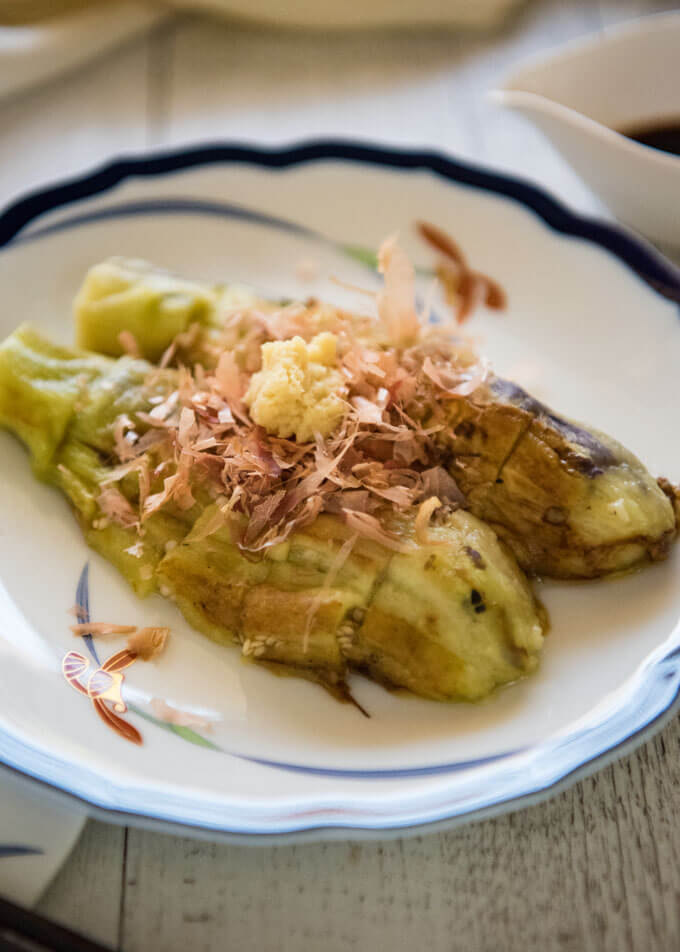
Western-style grilled eggplant dishes are made by cooking sliced eggplant over the grill, making the distinct charred lines on the eggplant pieces.
But Grilled Japanese Eggplant looks quite different. It is made by grilling a whole eggplant with the skin on until the flesh inside the skin becomes soft. Peel the skin off, then cut the flesh into bite size pieces.
Eggplants Suitable for Grilled Japanese Eggplant
Japanese eggplant is not very large. It is about 10cm/4” long and 4cm/1½” wide, unlike Aussie standard eggplant/American eggplant that can be 10cm/4” wide and 15cm+/6” plus long.
Small eggplants are perfect to make Yaki Nasu because of the way Yaki Nasu is grilled and served.
Where I live, the vegetable shops don’t sell Japanese eggplants but they do sell thin eggplants which can be anywhere between 10-15cm/4-6” long. I use these thin eggplants when I make Yaki Nasu.
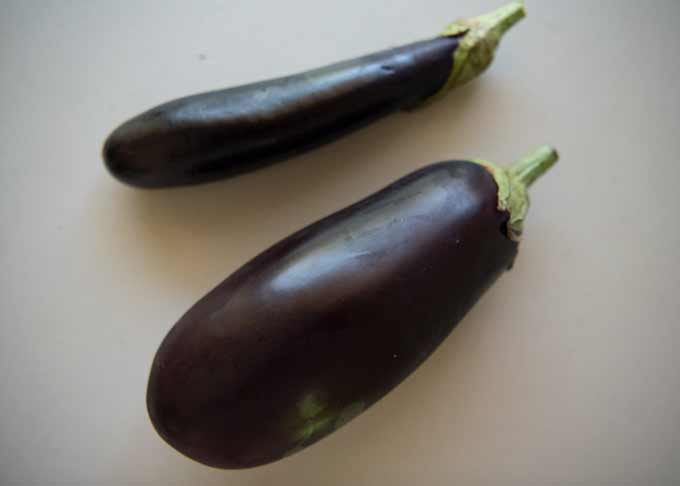
Thin long eggplant suitable for Yakinasu (top) and Aussie standard/American eggplant (bottom).
Large eggplants like the Australian standard eggplant can be grilled but it will take much longer to cook through the flesh. Also, the smoky flavour from the burnt skin does not penetrate sufficiently due to the thickness of the flesh.
How to Grill Eggplants
Before grilling, you need to prepare the eggplant so that it becomes easier to peel the skin off after grilling it. Place a knife crosswise at the top of the eggplant, just below where the fruit starts. Then move the knife around the eggplant to make a shallow incision (see the photo).
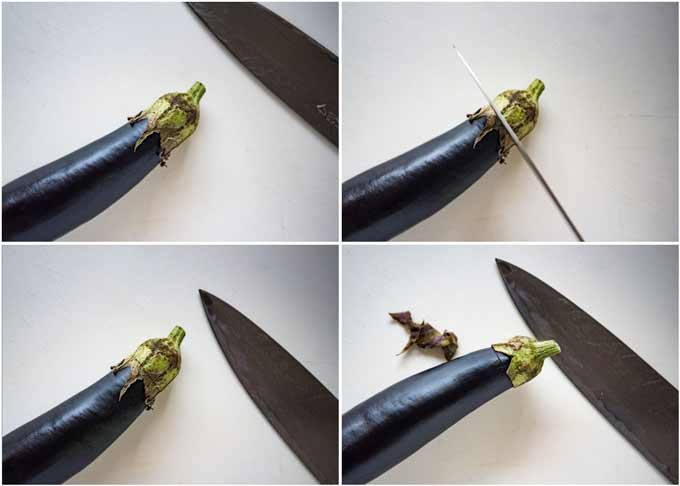
This will serve two purposes:
- The incision prevents the eggplant from bursting open when grilled.
- It makes the removal of the skin easier.
The tip of the eggplant needs to be intact but if the stem at the tip is very long, trim it to minimum length.
When the incision is made, place the whole eggplant on a grill at medium to medium-high heat and cook for about 10 minutes (for small eggplants). Rotate the eggplant a couple of times is that it cooks evenly and the skin gets burnt evenly.
Grilling Method
The fastest way to cook eggplant is to grill it with direct heat. It is OK for the skin to burn as the skin will be peeled off before serving. It is actually preferable to burn the skin so that the eggplant flesh gets a bit of smokiness.
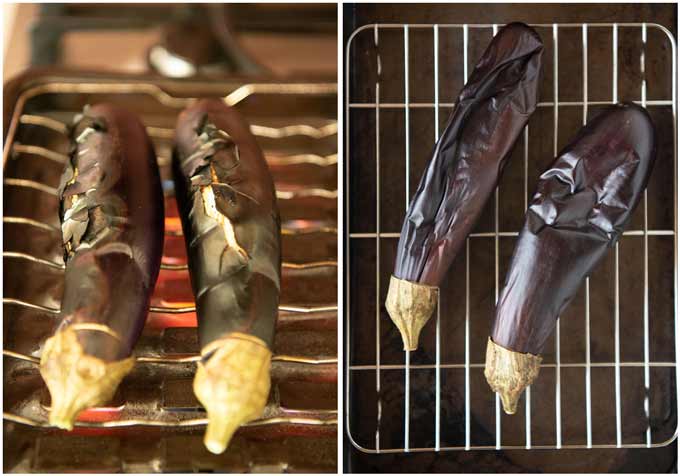
There are few methods of grilling eggplants:
- On the BBQ
- On a grilling net/basket over a stove (left photo above)
- Under a broiler (right photo above)
I like the first two methods above as the eggplant skin gets charred with flames (I use a gas stove), infusing a smoky flavour into the flesh of the eggplant better.
You could use a griddle or a frying pan but it might take a bit longer to cook.
Serving Grilled Japanese Eggplants
When you gently squeeze the grilled eggplant, you should feel that the flesh inside is very soft. As soon as the heat is turned off, the eggplant starts to get wrinkly. This is normal.
While the eggplant is still hot, pinch the top of the skin where the circle incision was made and peel a strip of skin off. Repeat until the skin is completely removed.
Remove the stem part (you can’t eat it) and cut the flesh into bite size pieces. If I was using a large eggplant, I would quarter the eggplant vertically, then cut the quarters into 2-3cm/1” wide pieces.
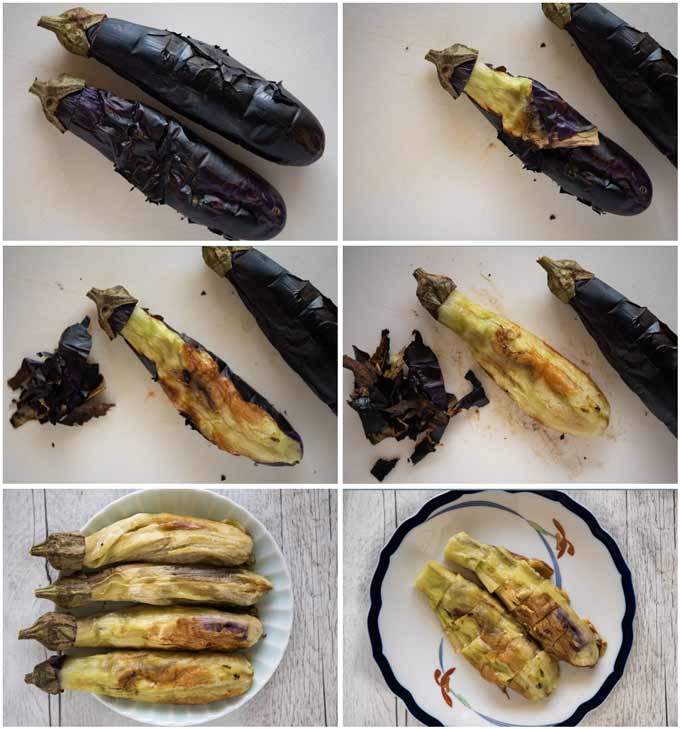
Garnishes to go with Grilled Eggplants
The most commonly used garnishes are grated ginger and/or bonito flakes. I like both. Sometimes I also add finely chopped shallots/scallions, but I think that only a small amount of shallots is sufficient. Too much overpowers the eggplant taste with a strong shallots smell.
I usually place bonito flakes, then grated ginger on top of eggplants. If adding shallots, I would sprinkle them over it.
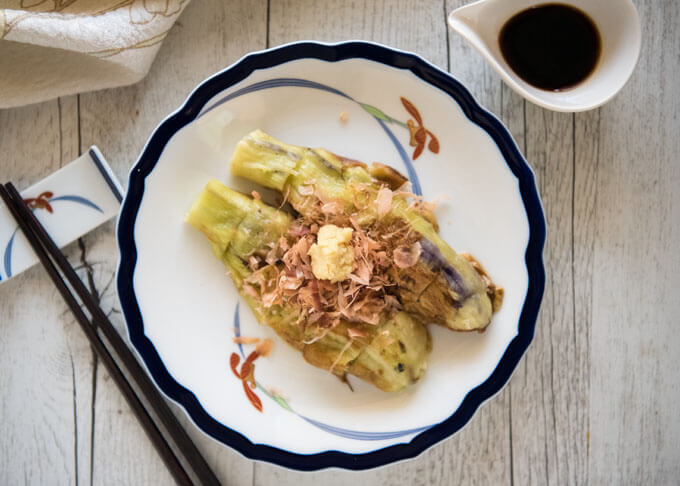
Yaki Nasu can be served warm, at room temperature or cold. You can even make it the day before and keep it in the fridge until you serve it.
Summer days in Japan can be very hot and humid which reduces people’s appetite. I used to have chilled Yaki Nasu on such day with Chilled Tofu (Hiyayakko) and Somen (Japanese Cold Noodles) to feel cool.
Yumiko![]()
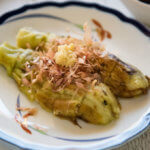
A very easy and delicious appetiser/side dish, Grilled Japanese Eggplant is called ‘Yaki Nasu’ in Japanese. The perfectly grilled eggplant is traditionally eaten with ginger, bonito flakes and a little bit of soy sauce. The eggplant melts in your mouth.
Omit bonito flakes to make it a vegetarian dish.
Don't forget to see the section 'MEAL IDEAS' below the recipe card! It gives you a list of dishes that I have already posted and this recipe that can make up a complete meal. I hope it is of help to you.
- 4 small eggplants , about 100g/3.5oz each (note 1)
- Soy sauce to serve
- 4 tbsp bonito flakes
- 1 tbsp grated ginger
- Finely chopped shallots/scallions (optional)
-
If your eggplant has a long stem, cut it short (easier to handle grilling).
-
Place a knife crosswise at the top of each eggplant, just below where the fruit starts. Then move the knife around the eggplant to make a shallow incision (see the photo in the post).
-
Place the eggplants on a grill net over a stove or BBQ grill grates (note 2).
-
Cook for about 10 minutes. Rotate the eggplants occasionally to cook all around the surface of the eggplants. Part of the eggplant skin should get burnt.
-
When the inside of the eggplant is soft, transfer to a cutting board.
-
Starting from the top of the eggplant where you made an incision around the eggplant, peel the skin off. It is easier to do this while still hot.
-
Cut the tip off, then cut the flesh into bite size pieces (note 3).
-
Plate the eggplant, topped with bonito flakes and grated ginger. If using shallots, sprinkle over it.
-
Serve with soy sauce while hot, at room temperature or even chilled (note 4).
-
Pour soy sauce over and eat with some toppings.
1. Small eggplants are perfect to make Yaki Nasu because of the way Yaki Nasu is grilled and served. If you can find Japanese eggplant, that would be the best. Otherwise, try smaller eggplants with the thickness of no larger than 4cm/1½”.
Where I live, vegetable shops and even supermarkets do sell thin eggplants, which can be anywhere between 10-15cm/4-6” long. I use them when I make Yaki Nasu.
If you can only find a large eggplant, i.e. standard Aussie eggplant/American eggplant, you will only need one eggplant for 2-3 servings, but you will need to grill much longer to cook through the flesh.
When I grilled a large eggplant under the broiler, it took me close to 30 minutes. It is important to turn the eggplant around for faster cooking. I turned it over after 10 minutes, then after another 10 minutes, I rotated 90 degrees. Cook few minutes, then turn it over to cook the other side for few more minutes.
2. I picked these heating methods so that the eggplant skin will burn nicely. You can also use a broiler/oven griller to get a similar effect. Cooking time is also similar.
You can use a griddle or frying pan as a last resort. It might take a bit longer to cook and the smokiness might be much less than the other methods, but you can still cook the eggplants through.
3. If you are making Yaki Nasu with a large eggplant, quarter the eggplant vertically first, then cut it into bite size pieces.
4. If serving your eggplants chilled, keep the grilled eggplants ready to serve in the fridge, without toppings. Add toppings at the time of serving.
5. If serving as an appetiser, one eggplant per serving should be sufficient.
6. Nutrition per serving, not including soy sauce.
serving: 206g calories: 57kcal fat: 0.4g (1%) saturated fat: 0g (0%) trans fat: 0.0g polyunsaturated fat: 0.2g monounsaturated fat: 0g cholesterol: 2mg (1%) sodium: 97mg (4%) potassium: 495mg (14%) carbohydrates: 13g (4%) dietary fibre: 6.1g (24%) sugar: 7.1g protein: 2.9g vitamin a: 1% vitamin c: 7.8% calcium: 1.6% iron: 2.9%
Meal Ideas
A typical Japanese meal consists of a main dish, a couple of side dishes, a soup and rice. I try to come up with a combination of dishes with a variety of flavours, colours, textures and make-ahead dishes.
Yaki Nasu is quite a refreshing light dish. Stir fry dishes or deep-fried dishes go perfectly with it. For Side dish 2, I picked Goma-ae to add a different flavour to the meal. But this can be replaced with any other side dish. If you are having Yaki Nasu in the summer time which is often the case in Japan, Chilled Tofu (Hiyayakko) might go better with it.
- Main: Chinjao Rosu (Japanese Stir Fry with Beef and Bamboo Shoots) – or something deep-fried.
- Side dish 1: Grilled Japanese Eggplant (Yaki Nasu) – today’s recipe, can make ahead
- Side dish 2: Chrysanthemum Leaves Goma-ae (Sweet Sesame Dressing)
- Soup: Tofu and Wakame Miso Soup
- Rice: Cooked Rice
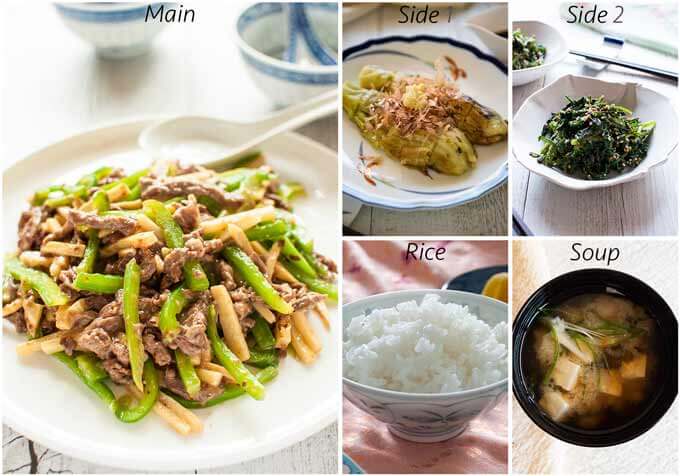
I lived in Japan for 7 years and loved all the wonderful food I are even the Nagoya Daigaku’s Shokudo. But I remember eating nasu like this only it was cooked in dashi.
Hi Helga, eggplant cooked in dashi is called ‘Nasu no Nibitashi’. After sautéing/frying nasu, cook them in soy-flavoured sweet dashi. Perhaps the texture of the eggplant flesh is similar (melts in your mouth) but you can see quite different flavours between the two.
Hi NAGI,
At VN my Mum she cook like that but she mix oil with shallots a top & pour fish sauce mixed 🌶, garlic, sugar & lime juice so yummy 😋
Hi Tina, your mum’s dressing sound delicious. I should try it.
Hi ,I have so many growing in garden in SA , this seems a great way to use them, but what is Bonito flakes?
Hi Friedi, bonit flakes is made from dried bonito fillets, then shaved finely. It is used to make dashi stock or as a topping to give umami to the dish. It usually comes in a pack and sold at Asian grocery stores. This link gives you the typical bonito flakes pack.
If you can get it, that will be great but you can still enjoy Yaki Nasu with just grated ginger.
I can’t wait to try this….Yum!
Hi Lyn, it is really delicious!
YUUUUM!!!! Sent to Parky – she is nuts for Japanese eggplant dishes!
Please do!